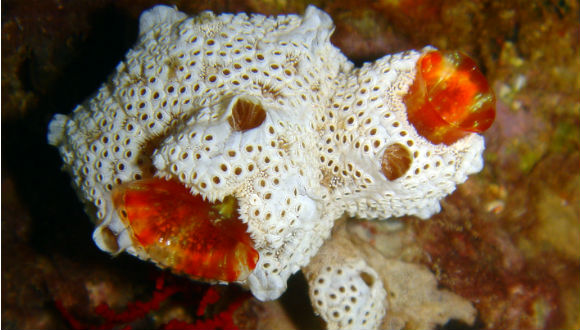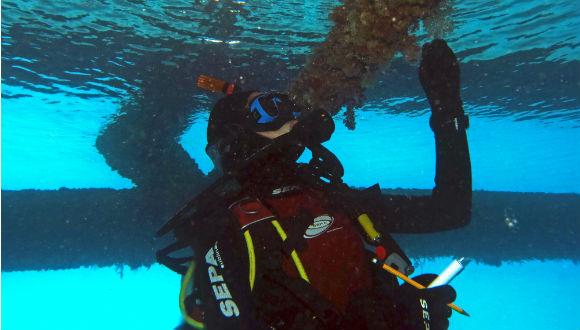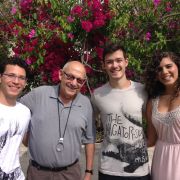To Name Is to Know: The Wonderful World of Taxonomy
In the rarified world of ascidian taxonomy – a field involving the classification of marine creatures that cling to hard surfaces on the ocean floor – Dr. Noa Shenkar of TAU’s Steinhardt Museum of Natural History, Israel National Center for Biodiversity Studies, has carved out a role as one of the world’s foremost authorities in the field. With her unique knowledge of ascidians from the Red and the Mediterranean Seas, Shenkar’s classifications are today considered definitive.
Shenkar is one of the 25 taxonomists at the Steinhardt Museum, which is currently under construction on the TAU campus.
Prof. Tamar Dayan, Director of the Museum, says, “Taxonomic research – identifying species and understanding their basic biology and evolutionary relationships – is key to conservation, sustainable use, and management of ecosystems. It’s also important for agriculture, health, biotechnology and security.
“The taxonomic work at the Museum is crucial for the basic and applied study of all living organisms. To cite the founding father of taxonomy, Carolus Linnaeus, ‘If the names are unknown, knowledge of the things also perishes,’” quotes Dayan.
Underwater monitors
Trained at TAU with a post-doctoral degree from the University of Washington at Seattle, Shenkar, 38, spends as much time as possible under the water. She is fascinated by ascidians – unique invertebrates also known as “sea squirts” that filter their food from the water. “Ascidians feed on the tiniest particles in the ocean, making them an important link in the food chain,” says Shenkar. “They also shed light on the condition of the marine environment.”

Pictured: Dr. Noa Shenkar
Shenkar is regularly approached by marine biologists throughout the Middle East, including from the Gulf States and Iran.
 Recently, Shenkar hosted Turkish researcher Dr. Sinem Aydin (pictured right) of Dokuz Eylul University’s Institute of Marine Sciences and Technology to train in her lab for a week. Aydin is researching the use of ascidians as biological indicators for monitoring heavy metal pollution in the Eastern Aegean waters.
Recently, Shenkar hosted Turkish researcher Dr. Sinem Aydin (pictured right) of Dokuz Eylul University’s Institute of Marine Sciences and Technology to train in her lab for a week. Aydin is researching the use of ascidians as biological indicators for monitoring heavy metal pollution in the Eastern Aegean waters.
“I came to Israel because Dr. Shenkar is an expert in this field of research. She gave me basic training in ascidian taxonomy and helped me improve my dissection skills and work with taxonomic keys for accurate identification,” says Aydin. “There is no expert in this field in Turkey so my experience at Tel Aviv University will go a long way to closing this deficit,” she says.
For Shenkar, cooperation with her Turkish colleague represents a way of promoting peace in the region through ascidians. “Of course, I can’t achieve peace on my own, but scientific dialogue is a step in the right direction,” she says.

Steinhardt Museum
The Steinhardt Museum of Natural History, Israel National Center for Biodiversity Studies, is a priceless national treasure with about 5 million specimens of animals and plants that tell the story of biodiversity of the Middle East during the past century and the history of humankind across millennia. Among the unique specimens are the last cheetah from the Middle East, the earliest modern humans out of Africa, the last leopards from the Galilee and the Judean Mountains, and evidence of the earliest farming communities in the Middle East.
Slated to open to the public in January 2017, the Museum is recognized as a national research infrastructure under the academic auspices of the Israel National Academy of Sciences and Humanities, and benefits from an association with TAU’s George S. Wise Faculty of Life Sciences, the Sackler Faculty of Medicine, and the Lester and Sally Entin Faculty of Humanities. It has an 80-strong staff and its core objectives are recording biodiversity, performing scientific study, training professionals and holding public outreach programs. Research at the Museum supports policy and decision makers across a wide range of areas, including agriculture, wetland management, marine resource exploitation, flight safety, health, landscape conservation and biological pest control, among others.
Each year, about 100,000 visitors are expected to visit the Steinhardt Museum. The new building encompasses 9,620 square meters and has many unique features. These include the Ark – an exhibition space evoking the Biblical Ark of Noah that will enable families and other visitors to get a rare glimpse of fascinating specimens from among the millions in the collection. Other facilities include the World of Knowledge Wing – a space for outreach and science-enrichment programs that will open up the world of higher education and scientific research to young people from all backgrounds, as well as train park rangers and nature guides.
 The building for the Steinhardt Museum of Natural History, Israel National Center for Biodiversity Studies, is made possible through the vision and generosity of major TAU benefactor and TAU honorary doctor Michael Steinhardt (pictured right), a former Chairman of the TAU Board of Governors, together with his wife, Judy. The Planning and Budgeting Committee of the Israel Council for Higher Education, government ministries, JNF and private donors and foundations support the Museum’s operations, activities and building process.
The building for the Steinhardt Museum of Natural History, Israel National Center for Biodiversity Studies, is made possible through the vision and generosity of major TAU benefactor and TAU honorary doctor Michael Steinhardt (pictured right), a former Chairman of the TAU Board of Governors, together with his wife, Judy. The Planning and Budgeting Committee of the Israel Council for Higher Education, government ministries, JNF and private donors and foundations support the Museum’s operations, activities and building process.






